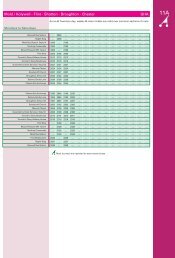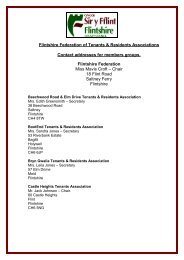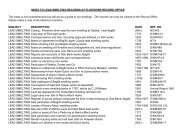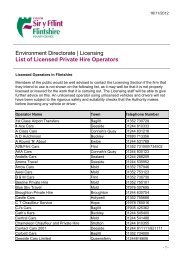Caerwys Eng.indd - Flintshire County Council
Caerwys Eng.indd - Flintshire County Council
Caerwys Eng.indd - Flintshire County Council
Create successful ePaper yourself
Turn your PDF publications into a flip-book with our unique Google optimized e-Paper software.
Greater spotted<br />
woodpecker<br />
A place for wildlife<br />
<strong>Caerwys</strong> lies on the northern side of the Wheeler Valley, a landscape<br />
of rolling farmland, thick hedgerows and wooded valleys, with<br />
the open moorland of the Clwydian Range to the south and west.<br />
The Clwydian Range was designated an Area of Outstanding<br />
Natural Beauty in 1985 in recognition<br />
of its nationally important landscape<br />
quality. It is one of only eight protected<br />
landscapes in Wales, five AONBs and<br />
three National Parks. A good network of<br />
footpaths, bridleways and quiet lanes enable<br />
easy exploration of the area.<br />
Herb Paris<br />
An unusual array of plants grow in the damp<br />
soils of the wooded valleys, including herb Paris<br />
and many ferns and mosses. In early spring the<br />
woodlands are dotted with primrose, lesser celandine and wood<br />
anenomes. By late spring, pungent wild garlic and bluebells carpet<br />
the woodland floor and early purple orchid and twayblade can<br />
also be found.<br />
Wildflowers thrive on the drier grassland including knapweed,<br />
cow parsley, red campion, meadow vetch and common spotted<br />
orchid. Field edges, hedgerows and road verges are a riot of<br />
colour in summer. The flowers in turn attract butterflies and<br />
other insects to gather nectar. Plants<br />
such as ragged robin and tall,<br />
feathery-flowered meadowsweet<br />
grow in damper places.<br />
Dipper<br />
Red Admiral<br />
Tortoisehell<br />
The rich mixture of woodland, mature hedges,<br />
fields and verges provide homes and food for<br />
many birds and animals. There are many active badger setts<br />
and, in spring, the woodlands resound with birdsong as birds<br />
compete to find a mate. The native species, such as coal tits,<br />
great tits, greater spotted woodpecker and nuthatch are<br />
joined by numerous summer migrants, including chiff-chaff,<br />
willow warbler and spotted flycatcher.<br />
Skylarks and lapwings are increasingly rare nationally, but are still seen<br />
on farmland around <strong>Caerwys</strong>. In winter, flocks of redwing are common and<br />
birds like goldfinches and siskins are seen feeding in large flocks.<br />
Rabbits, mice, voles and grey squirrels abound and hares are<br />
sometimes seen in the fields. These provide plentiful food for<br />
foxes, stoats and birds of prey. Buzzards are frequently seen<br />
circling overhead and smaller kestrels<br />
hovering above a roadside verge.<br />
Sparrowhawks may be spotted flying<br />
fast and low in pursuit of its prey<br />
of small birds and red kites have<br />
occasionally been seen.<br />
Badger<br />
The lakes and the faster flowing<br />
rivers provide other rich wildlife habitats. Coots and ducks<br />
thrive on the lakes and herons are often seen standing in the<br />
water looking for fish. In summer, swallows and house martins fly<br />
acrobatically above the water hunting flying insects.<br />
Common spotted<br />
orchid









